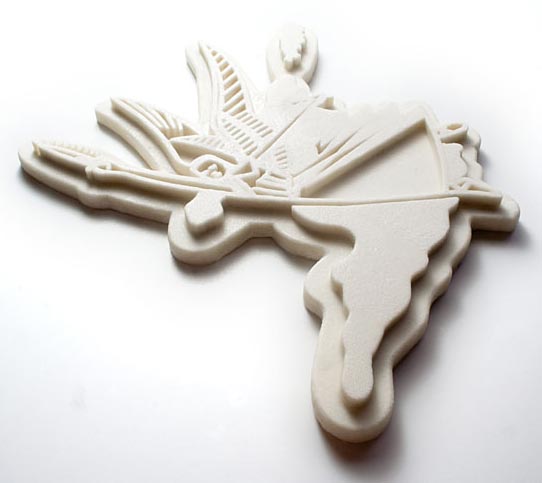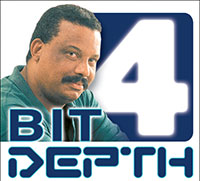BitDepth 500 - November 22
11/01/09 17:44 Filed in: BitDepth - November 2005
Brett Lewis is working with a machine that turns virtual models into real ones.
Virtual becomes real

What to model that couldn't have been done anywhere else? A vector file of the old Guardian logo was extruded on the prototyping machine to create this plaque, done overnight by Eyescream Animation. In the process I got a short less on in volumetrics and connectors, and some of the problems that 3D animators face when making objects out of flat artwork. Photography by Mark Lyndersay.
Brett Lewis spends his working days in virtual worlds, tweaking splines and nurbs, skinning wireframes and creating, for his clients, remarkable illusions of buildings that exist only as lines in architect's CAD software.
His business is visualisation, creating digital simulacra of buildings and of cartoon characters for advertising. Lewis got his start in a refurbished garage at his parent's home in 1991, and formally established Eyescream animation in 2000.
Tall, with a shock of brilliant blonde hair and deep-set, piercing eyes, Lewis talks his business with an enthusiasm that's infectious. His Belmont office is papered with huge prints of buildings rendered in software, many now built or under construction that shimmer in computer generated sunlight.
Eyescream is buzzing with activity now, the staff of six each peering intently into huge LCD screens that flicker with lines and shapes that connect and flit into place as buildings metamorphose from skeletal matchstick shapes into the virtual wonders that the company trades in.
There are other companies that do this type of work but Eyescream is infected with Lewis' enthusiasm for the new and cutting edge. That restlessness has brought the company six local AATT awards and an international Addy for their work on local advertising campaigns. The 3D animation that illustrated Mr Humphrey's arch intersection was also rendered here.
After more than a decade of pushing vectors and pixels, Brett Lewis is taking his work back into the meat world of touch and feel with a new printer that takes the virtual shapes rotating on the screens at his office and turning them into gorgeously detailed beige models.
The technology is called rapid prototyping, and it has its origins in engineering as a way of testing designs and concepts quickly. The machine is from ZCorp and it's a particularly uninteresting box that looks like a top-heavy refrigerator.
It's what it does that's amazing. Eyescream modeller Jaime Hamel-Smith pulls up a modelled cupola that's scheduled for printing on the device. The young man, face grizzled with earnest new fuzz, stares intently in the glow of the huge monitor, flipping the model up and down and from side to side.
Curious, I ask what he's looking for. "Reversed normals," he mutters, twisting the wireframe, studded like a porcupine, around vigorously.
Satisfied, he then runs a test on the model and an aquamarine outline begins at the top of the model and slowly glides down, sliver by sliver, like a scanner in a James Bond film.
This is how the prototyping machine creates its magic, reading and then "printing" binder fluid onto a tiny sliver of powder just 3/1000ths of an inch thick, one layer at a time.
As the printer kicks in, the fluid head squirting across the surface of a fine mesh screen of powder, Jaime notes that the fun is over, the rest is "like watching grass grow."
What the printer does is build a cube of powder that's eight inches tall, eight inches wide and ten inches deep at its maximum and inside it is the model, distinguished only by the binder fluid that holds the fine powder together.
Now the fun begins, and the tray full of powder is gently carried to a blower bin, a sealed box with an airbrush hose in it, where, inch by inch, the model, only a shade more robust than the powder surrounding it, is cleaned up.
For finely detailed models, it's like digging crumbling papyrus out of a sandbox. Too little cleaning and unsightly powder clings to the model; too much and it breaks like a sandcastle.
Brett hands me an uncured model of a sword and as I hold it, I feel the powder falling off it. I squeeze gently, and the blade breaks like bread crust. Hamel-Smith grins, "Don't worry, it was already broken."
Eyescream is still looking for a convection oven to speed the curing process and daily experiments with curing and hardening solutions continue. The final models, properly dried and hardened are like rocks, far from the fine almost insubstantial bound powder that emerges from the Prototyping printer.
These early models are small, just tests of the system. Soon Brett plans to build huge models by designing interlocks into the models so he can create much larger constructs by assembling them like Lego parts.
The work is impressive and finely detailed, but Brett still isn't satisfied.
"I can see where all this technology begins to diffuse into the mainstream of the business," he says. "Already, architects are building 3D drafting into their workflows. We have to keep working to stay ahead."
Then, almost as an afterthought, he shows me the sales reel for The Resnaissance at Shorelands, a massive upscale housing project. The reel opens with a helicopter flyby of the project, massive towers gleaming against the emerald green of the hillsides behind them. I blink for a moment before realising that it can't be real. It just doesn't exist yet.
Then the camera zooms in on the project and flys through it, animated people splashing in pools, walking by as doors fly open for the speeding camera before coming to a dizzying halt before an astonishing view of the ocean.
As it ends, I stifle my first reaction, which is to yell "again!"

What to model that couldn't have been done anywhere else? A vector file of the old Guardian logo was extruded on the prototyping machine to create this plaque, done overnight by Eyescream Animation. In the process I got a short less on in volumetrics and connectors, and some of the problems that 3D animators face when making objects out of flat artwork. Photography by Mark Lyndersay.
Brett Lewis spends his working days in virtual worlds, tweaking splines and nurbs, skinning wireframes and creating, for his clients, remarkable illusions of buildings that exist only as lines in architect's CAD software.
His business is visualisation, creating digital simulacra of buildings and of cartoon characters for advertising. Lewis got his start in a refurbished garage at his parent's home in 1991, and formally established Eyescream animation in 2000.
Tall, with a shock of brilliant blonde hair and deep-set, piercing eyes, Lewis talks his business with an enthusiasm that's infectious. His Belmont office is papered with huge prints of buildings rendered in software, many now built or under construction that shimmer in computer generated sunlight.
Eyescream is buzzing with activity now, the staff of six each peering intently into huge LCD screens that flicker with lines and shapes that connect and flit into place as buildings metamorphose from skeletal matchstick shapes into the virtual wonders that the company trades in.
There are other companies that do this type of work but Eyescream is infected with Lewis' enthusiasm for the new and cutting edge. That restlessness has brought the company six local AATT awards and an international Addy for their work on local advertising campaigns. The 3D animation that illustrated Mr Humphrey's arch intersection was also rendered here.
After more than a decade of pushing vectors and pixels, Brett Lewis is taking his work back into the meat world of touch and feel with a new printer that takes the virtual shapes rotating on the screens at his office and turning them into gorgeously detailed beige models.
The technology is called rapid prototyping, and it has its origins in engineering as a way of testing designs and concepts quickly. The machine is from ZCorp and it's a particularly uninteresting box that looks like a top-heavy refrigerator.
It's what it does that's amazing. Eyescream modeller Jaime Hamel-Smith pulls up a modelled cupola that's scheduled for printing on the device. The young man, face grizzled with earnest new fuzz, stares intently in the glow of the huge monitor, flipping the model up and down and from side to side.
Curious, I ask what he's looking for. "Reversed normals," he mutters, twisting the wireframe, studded like a porcupine, around vigorously.
Satisfied, he then runs a test on the model and an aquamarine outline begins at the top of the model and slowly glides down, sliver by sliver, like a scanner in a James Bond film.
This is how the prototyping machine creates its magic, reading and then "printing" binder fluid onto a tiny sliver of powder just 3/1000ths of an inch thick, one layer at a time.
As the printer kicks in, the fluid head squirting across the surface of a fine mesh screen of powder, Jaime notes that the fun is over, the rest is "like watching grass grow."
What the printer does is build a cube of powder that's eight inches tall, eight inches wide and ten inches deep at its maximum and inside it is the model, distinguished only by the binder fluid that holds the fine powder together.
Now the fun begins, and the tray full of powder is gently carried to a blower bin, a sealed box with an airbrush hose in it, where, inch by inch, the model, only a shade more robust than the powder surrounding it, is cleaned up.
For finely detailed models, it's like digging crumbling papyrus out of a sandbox. Too little cleaning and unsightly powder clings to the model; too much and it breaks like a sandcastle.
Brett hands me an uncured model of a sword and as I hold it, I feel the powder falling off it. I squeeze gently, and the blade breaks like bread crust. Hamel-Smith grins, "Don't worry, it was already broken."
Eyescream is still looking for a convection oven to speed the curing process and daily experiments with curing and hardening solutions continue. The final models, properly dried and hardened are like rocks, far from the fine almost insubstantial bound powder that emerges from the Prototyping printer.
These early models are small, just tests of the system. Soon Brett plans to build huge models by designing interlocks into the models so he can create much larger constructs by assembling them like Lego parts.
The work is impressive and finely detailed, but Brett still isn't satisfied.
"I can see where all this technology begins to diffuse into the mainstream of the business," he says. "Already, architects are building 3D drafting into their workflows. We have to keep working to stay ahead."
Then, almost as an afterthought, he shows me the sales reel for The Resnaissance at Shorelands, a massive upscale housing project. The reel opens with a helicopter flyby of the project, massive towers gleaming against the emerald green of the hillsides behind them. I blink for a moment before realising that it can't be real. It just doesn't exist yet.
Then the camera zooms in on the project and flys through it, animated people splashing in pools, walking by as doors fly open for the speeding camera before coming to a dizzying halt before an astonishing view of the ocean.
As it ends, I stifle my first reaction, which is to yell "again!"
blog comments powered by Disqus

